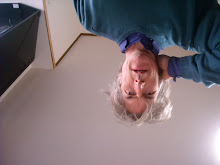
Well, today it is raining hard, off and on lightly. I woke a bit before 6am, and was called by my daughter Hannah. After putting her back to sleep, it was time to relight the wood fired oven. Last night it was burning, we had pizza for dinner. So it did not take much or long to get the temperatures back up to around 250 degree centigrade. On the left is a photograph of the oven re-firing to restore the the temperatures adequate to baking bread. The small pile of wood, perhaps 6 or 7 logs is burning in the middle of the oven, a little to the back, and it is easy to see the flames roaring up, following the curve of the oven to the front to send the fumes up the chimney. While this was occurring I started the next batch of bread and pizza doughs - recipes available on request - as well as a fresh polish starter. Also made yoghurt, and muffins for breakfast. meantime Hannah got up, ate yoghurt and strawberries while watching the 1950 version of Hitchcock's The Man Who Knew Too Much, not the earlier 1930s B&W one; she said this was scary at one point. The muffins were baking at the entrance of the oven, as the centre was way too hot at 250 for baking muffins, chocolate for Hannah, her favourites, and blueberry muffins for us. Bowls of beans are soaking in preparation for their long slow cooking in the reducing oven temperatures.
Yesterday arrived a new, hardback copy of Elizabeth David's incredible book, English Bread and Yeast Cookery, bought second hand through internet shopping. I original purchased this book around 1982, and used it to study how to make bread. My first fully successful bread used the overnight, slow rise recipe from that book, and many others followed. There is a superb recipe there for making a blue cheese quiche using a yeast risen pastry, that I used to bake regularly for a café in Glasgow, a while ago... But, the original book has begun to disintegrate, the pages are falling out and it is difficult to maintain them in proper order. So now with this new copy, I again reread the earlier chapters. The book is a mine of information on bread baking through the centuries from earliest times. There are chapters dealing with each element of bread making, flour, yeast, salt, water, milks, sugars, fruits, spices, and so on, with an excellent section on bread ovens, starting from the baking stone, the inverted clay pots and onto today with a great deal of information on the construction and use of wood fired ovens, which I am now studying with relish, to discover what a 'watch and tell' pebble is, used to determine ideal oven temperatures for bread baking. (For that an infra-red thermometre measures more precisely.) If you do not have this book, and wish to bake breads, it is something that should sit proudly on the kitchen bookshelf; also it is a history and a literary entertainment in itself, with frequent quotations from cookbooks of lore and literature on breads, yeast cakes, and all sorts of yeast cooking. (We watched a couple of TV biographies of Elizabeth David, which were both informative of here cooking life and skills and also of her private sexuality. She was a more colourful character than imagined.)

I'm very envious of all your baking - but my elder son and I are both allergic to yeast of all things so bread has been off the menu for over two years now. REALLY SAD :(
ReplyDeleteStill like reading about it though!!
Vicky,
ReplyDeleteHave you tried natural leaven breads? Did you make these yeast breads that you are allergic too yourself, or were they store bought?
If yeast it your problem you do not have to give up on bread, as you can eat soda breads, e.g., Irish soda bread, risen with baking soda and buttermilk or yoghurt. You can also eat flat breads like Matzoh, chappatti.
If you need recipes, let me know.
Cheerio,
Allan.
It's any kind of yeast - so I can't drink wine or beer, sob!
ReplyDeleteWe eat tortillas (bought usually), muffins, pancakes, scones etc. If you have a simple soda bread recipe I'd be happy to try that too!
Vicky,
ReplyDeleteThere are two methods to make soda breads and scones. They are very fast, as all that is required is to gather the dry ingredients, mix in the wet ingredients quickly; the faster the better for lighter breads/scones, and then bake, cook on a griddle. These are not as good as yeast risen breads, but they are delicious and all the better because they can be tossed off in half an hour or thereabouts. I will post a recipe(s) to my blog later.
I asked about the commercial bread because they use commercially produced yeasts, as does beer production. These usually use nutrients and chemical ingredients to foster yeast growth and to stabilise it thereafter. Natural leaven breads rely on what is absorbed from the atmosphere to rise the bread, commercially produced sour dough breads usually use yeast to supplement the natural leaven rise. Home produced sour dough uses only environmental flora and fauna to raise the breads, and should be less likely to provoke allergic reactions in consequence.